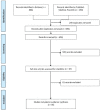Zinc, Magnesium, and Copper Levels in Patients with Sickle Cell Disease: A Systematic Review and Meta-analysis
- PMID: 35833156
- PMCID: PMC9272455
- DOI: 10.1055/s-0042-1749612
Zinc, Magnesium, and Copper Levels in Patients with Sickle Cell Disease: A Systematic Review and Meta-analysis
Abstract
Background Sickle cell disease (SCD) is associated with oxidative stress due to an imbalance between production and elimination of the reactive oxygen species. It has been reported that SCD patients are at risk of multiple micronutrients' deficiencies, including several trace elements involved in the antioxidation mechanisms. We aimed to assess the status of these micronutrients in SCD patients. Methods This study was conducted according to the Preferred Reporting Items for Systematic Reviews and Meta-analyses (PRISMA) guidelines. The databases of MedLine, Embase, and PsycInfo were used for the systematic search from time the databases existed until April 2021. A total of 36 studies fulfilled the eligibility criteria. We calculated the pooled standardized mean difference (SMD) of serum zinc, magnesium, or copper levels among patients with SCD and their healthy controls. Results SCD patients had significantly lower zinc (SMD = -1.27 [95% CI: 1.67-0.87, p 0.001]) and magnesium levels (SMD = -0.53 [95% CI: 1.0-0.06, p 0.026] than their controls. Copper level was found to be significantly higher in SCD patients, with SMD = 0.68 (95% CI: 0.05-1.32, p 0.004). Conclusion This review showed that SCD patients may potentially prompt to have lower zinc and magnesium levels and higher copper levels compared with those without the disease. Future research need to be directed to investigate clinical outcome of nutritional difficiencies in patients with SCD, as well as the possibility of implementing nutritional supplement programs which may help minimizing the harmful effects of the disease on human body.
Keywords: SCD; copper; magnesium; sickle cell; zinc.
Syrian American Medical Society. This is an open access article published by Thieme under the terms of the Creative Commons Attribution-NonDerivative-NonCommercial License, permitting copying and reproduction so long as the original work is given appropriate credit. Contents may not be used for commercial purposes, or adapted, remixed, transformed or built upon. ( https://creativecommons.org/licenses/by-nc-nd/4.0/ ).
Conflict of interest statement
Conflict of Interest None declared.
Figures




Similar articles
-
Thyroid function abnormalities in individuals with sickle cell disease: a meta-analysis.Thyroid Res. 2025 Feb 3;18(1):3. doi: 10.1186/s13044-024-00220-9. Thyroid Res. 2025. PMID: 39894795 Free PMC article. Review.
-
Plasma Zinc and Magnesium Levels in Sickle Cell Disease Patients in Latakia, Syria.Cureus. 2025 May 5;17(5):e83526. doi: 10.7759/cureus.83526. eCollection 2025 May. Cureus. 2025. PMID: 40470433 Free PMC article.
-
Serum Iron Levels and Copper-to-Zinc Ratio in Sickle Cell Disease.Medicina (Kaunas). 2019 May 21;55(5):180. doi: 10.3390/medicina55050180. Medicina (Kaunas). 2019. PMID: 31117252 Free PMC article.
-
Nutritional perspectives on sickle cell disease in Africa: a systematic review.BMC Nutr. 2021 Mar 18;7(1):9. doi: 10.1186/s40795-021-00410-w. BMC Nutr. 2021. PMID: 33731225 Free PMC article.
-
Correlates of gallbladder stones among patients with sickle cell disease: A meta-analysis.JGH Open. 2021 Aug 7;5(9):997-1003. doi: 10.1002/jgh3.12622. eCollection 2021 Sep. JGH Open. 2021. PMID: 34584966 Free PMC article. Review.
Cited by
-
Thyroid function abnormalities in individuals with sickle cell disease: a meta-analysis.Thyroid Res. 2025 Feb 3;18(1):3. doi: 10.1186/s13044-024-00220-9. Thyroid Res. 2025. PMID: 39894795 Free PMC article. Review.
-
Sickle Cell Disease and Lead Poisoning in New York City, 2005-2019.Pediatrics. 2024 Oct 1;154(Suppl 2):e2024067808G. doi: 10.1542/peds.2024-067808G. Pediatrics. 2024. PMID: 39352034 Free PMC article.
-
Plasma Zinc and Magnesium Levels in Sickle Cell Disease Patients in Latakia, Syria.Cureus. 2025 May 5;17(5):e83526. doi: 10.7759/cureus.83526. eCollection 2025 May. Cureus. 2025. PMID: 40470433 Free PMC article.
References
Publication types
LinkOut - more resources
Full Text Sources
Miscellaneous

